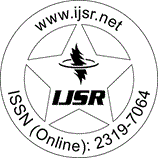Downloads: 2
India | Biomedical Sciences | Volume 14 Issue 10, October 2025 | Pages: 740 - 748
Effect of Exogenous Melatonin to treat on Anxiety Disorders in Girls During Puberty
Abstract: Anxiety disorders are increasingly prevalent among adolescents, particularly among early to mid-pubertal girls, who face heightened biological and psychosocial vulnerability during pubertal transition. Almost one in three (31.9%) adolescents aged 13-18 suffer from anxiety disorders, which include generalised anxiety disorder, panic disorders, specific phobias, agoraphobia, obsessive-compulsive disorder, post-traumatic stress disorder, and separation anxiety disorder (Anxiety Disorders | Knowledge Action Portal on NCDs, 2025) Anxiety disorders not only hamper the daily schedule of the adolescent, but also undermine their academic performance, social interactions and relationship quality. Furthermore, it causes emotional distress as well as takes a toll on physical health, causing symptoms such as fatigue, fast heartbeat, trembling, headaches, sleep disturbances, and shortness of breath, among others. Melatonin, a neurohormone produced by the pineal gland, is widely recognised for its role in sleep regulation from an early stage; however, recent evidence suggests its potential anxiolytic effects. A study conducted in Iran in 2013 demonstrated that sublingual melatonin given before cataract surgery under topical anesthesia effectively reduced patient anxiety and improved operating conditions. A 3 mg dose of sublingual melatonin was given 60 minutes before surgery, which was effective for sedation, offering a timely onset and sustained peak levels during the procedure. This dose falls within the 0.3?10 mg range, known to produce similar hypnotic effects, supporting its suitability for premedication (Khezri & Merate, 2013). A second study conducted in China in 2024 proved that melatonin reduced depression like behaviour caused by chronic stress in rats. It was found that melatonin alleviated the CRS-induced hippocampal microglial pyroptosis and depression-like behaviour in rats by inhibiting the Cathepsin B/NLRP3 signalling pathway (Gao et al., 2024). However, the gender and age-specific efficacy of melatonin in treating anxiety remains underexplored, especially in adolescent girls undergoing puberty. A lack of targeted research and clinical guidelines for this subgroup limits the potential therapeutic use of melatonin in anxiety management. Given its accessibility and affordability, melatonin presents itself as a compelling alternative for the treatment of anxiety disorders, especially in low- and middle-income countries. The current systematic review aims to compile the findings from the plethora of available studies that report the exogenous usage of melatonin drugs to treat anxiety, as well as the pathways in which the drug could potentially help to counter anxiety. This can have significant implications for clinical practice and treatment, including the management of anxiety in adolescent girls.
Keywords: anxiety disorders, melatonin, puberty, adolescent girls
How to Cite?: Hridhya Bhatiani, "Effect of Exogenous Melatonin to treat on Anxiety Disorders in Girls During Puberty", Volume 14 Issue 10, October 2025, International Journal of Science and Research (IJSR), Pages: 740-748, https://www.ijsr.net/getabstract.php?paperid=SR25926172834, DOI: https://dx.doi.org/10.21275/SR25926172834
